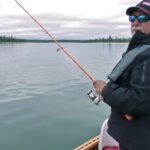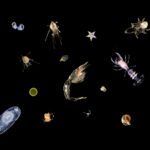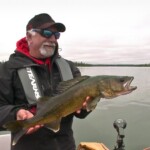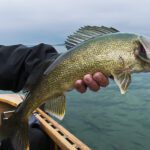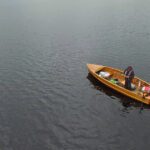On the previous Fish’n Canada episode, we talked about how Nagagami Lake is the perfect spot to showcase new, incredible advancements in underwater sonar products. After all, Nagagami is a glacial lake that formed about 10,000 years ago by the retreat of a massive glacier called the Laurentide Ice Sheet—this means there’s all kinds of underwater structure. The Laurentide Ice Sheet extended as far west as central Manitoba, as far south as the Great Lakes, and as far east as central Quebec and the St. Lawrence River.
In fact, many of the hundreds of thousands of lakes across this vast area were formed during this glacial retreat. They were so impacted by the sheer weight of this ice sheet that the surrounding earth is still rebounding. In fact, the surface area of many of these lakes is getting smaller as the earth tries to bounce back to its pre-glacial shape.
This explains the rough, multi-layered bottom of Nagagami Lake.
The extensive inflows and outflows provide nutrients and great water circulation; this is Walleye heaven!
On that previous episode, “hot-as-a-pistol Pete” ran a clinic on how to catch these Walleye. We didn’t know it at the time, but he was fishing on the cusp of a pre-frontal low; in addition to the sophisticated electronics he was using, Mother Nature was giving him a huge leg up.
MOTHER NATURE IS IN POWER
We’ve all heard the stories: “Not one bite all day, cold front came through.” Or “We’re into a cold front, don’t bother goin’ out.” Or most famously, “You shoulda been here yesterday!”
So what’s really happening?
It’s about changes in barometric pressure in the air and water, and the effect these changes have on an ecosystem.
Before a front the pressure drops, and after a front the pressure rises. Fishing is typically amazing during the pre-frontal low and a disaster during the post-frontal high. The explanation lies at the very bottom of the food chain with microscopic sized animals called zooplankton and phytoplankton.
Normal barometric pressure is considered to be about 30 inches of mercury or 762 mm.
A slight preliminary drop in pressure, as little as a millimetre or two, is negligible to us or even the larger predator fish. But it can affect the buoyancy of these tiny creatures; it pushes them out of their comfort zone, making them slightly unstable and vulnerable to predation.
So when tiny bait-fish gather to start feeding on them, it starts a chain reaction. A feeding frenzy. Once that party starts, it’s all over but the catching—because the fishing is typically amazing!
Like a domino effect, each level of predator starts to gorge and congregate in these areas.
This usually lasts about 12 hours. As the pressure and temperature continue to drop, however, the fishing goes from really good to really bad, really quick!
As the microscopic life continues to become unstable, so does their reproductive cycle, resulting in the deterioration of the primary food source in that body of water. In other words, the shelves in the grocery store are now near-empty and it doesn’t take long for the shoppers to stop coming in.
This is where Mother Nature performs her magic. Instinctively, each level of predatory fish starts shutting down in anticipation of this temporary food shortage.
It’s important to note that shutting down does not mean they won’t eat; it means that their energy consumption meter has been dialled down to C for conserve.
During this period, which can last anywhere between 24 to 72 hours, the feeding zone of a mid-range predator like a Largemouth Bass can go from several hundred feet to as little as six inches in just a matter of hours.
WHERE ARE ALL THE FISH
A good angler can take advantage of this by understanding what’s happening down there.
There’s a common misconception that when a front moves in, the fish disperse and go into the deepest part of the lake, becoming impossible to catch.
Nothing could be further from the truth. All they do is go to their comfort zone and stay put.
That could be deep water, shallow water, weed beds, breaklines, or undercut banks to name a few. They tend to look for places that offer shelter from other predators but still have the potential for ambushing a quick meal.
Remember, energy conservation is in effect, so they aren’t likely to chase baits. But vertical presentations into good cover or deep structure will usually result in some of the best fishing days you’ll ever have.
“Knowing what a great day Pete had at that spot, I naturally used the waypoints he put into the Garmin and made my way there,” says Ang. “But this day was different: much cloudier and stiller water. I knew a front had moved in and, given the clouds, it was a low-pressure front.”
Sure enough, the small area Pete in which had such success was now empty. Nothing on the Garmin and no hits casting. Where did Pete’s fish go? It was something Ang had to figure out.
Knowing that Nagagami has tons of structure, Ang took a quick look at the contour map on the Garmin. He could see changes in depth very close to Pete’s hunting ground.
All he did was move the boat a little, over a deeper trough, and there they were.
“The fish had just slid over and dropped down a few feet. I know that when this happens, they’re not going to be actively feeding. I’m gonna have to drop my bait right on their noses, and with the Garmin, it shouldn’t be that difficult”.
With the Walleye being so lethargic, the bait will have to be close and enticing. So minnows would be the preferred bait.
And preferred they were. By that simple move deeper, Ang had found Pete’s school—or maybe even a completely different group of fish—and saved the day.
The takeaway from this experience is: Don’t get depressed when the weather changes on you. Learn about the water you’re going to fish. Find the structure and you’ll find the fish.
SPECIAL THANKS
- Timberwolf Lodge on Nagagami Lake
- Days Inn & Suites Sault Ste. Marie
- Go Fish In Ontario
- Ontario’s Algoma Region
- Kathy and Derrick Carlson
- Forde Lake Air Service





